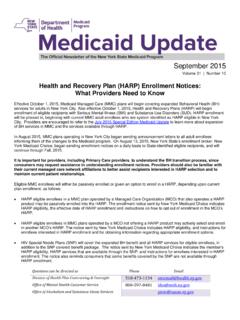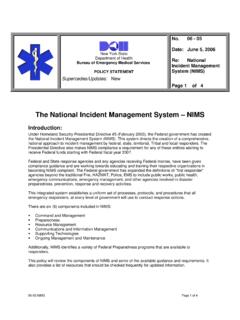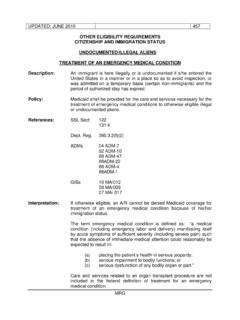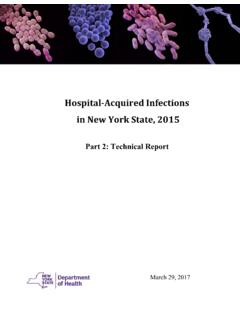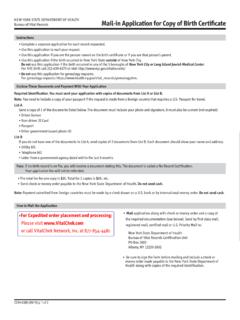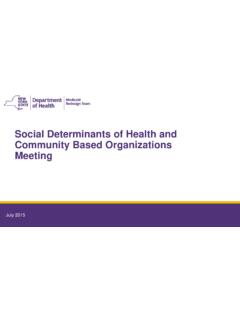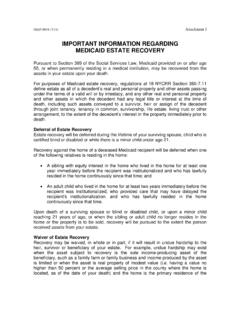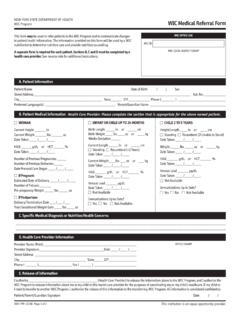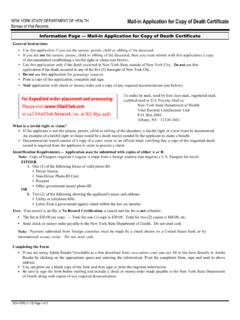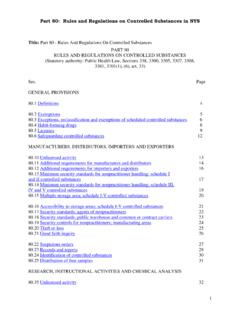Transcription of Collaborative Advanced Life Support Adult and Pediatric ...
1 Collaborative Advanced Life Support Adult and Pediatric Treatment Protocols 2019 Version [April 12, 2019] Effective August 1, 2019 Version 011619A 1 Index Introduction ..6 Pediatric Definition and Discussion ..8 Acknowledgements ..9 ( ) General Approach to Prehospital Care .. 10 ( ) General Approach to the EMS Call .. 11 ( ) General Approach to the Patient .. 13 ( ) General Approach to Safety Restraining Devices .. 16 ( ) General Approach to Transportation .. 17 ( ) Extremis/Cardiac Arrest Protocols .. 19 ( ) Cardiac Arrest: General Approach .. 20 ( ) Cardiac Arrest: General Approach Pediatric .. 23 ( ) Cardiac Arrest: Asystole or Pulseless Electrical Activity (PEA) Adult .. 25 ( ) Cardiac Arrest: Asystole/Pulseless Electrical Activity (Pea) Pediatric .. 27 ( ) Cardiac Arrest: Ventricular Fibrillation or Pulseless V Tachycardia 29 ( ) Cardiac Arrest: Ventricular Fibrillation or Pulseless V Tachycardia Pediatric .
2 31 ( ) Foreign Body Obstructed Airway .. 33 ( ) Foreign Body Obstructed Airway Pediatric .. 34 ( ) Obvious Death .. 35 ( ) Respiratory Arrest/Failure Adult .. 37 ( ) Respiratory Arrest/Failure Pediatric .. 38 ( ) Return of Spontaneous Circulation Adult .. 39 ( ) Termination of 41 ( ) General Adult And Pediatric Medical 43 ( ) Alte/Brue Pediatric .. 44 ( ) Altered Mental 45 ( ) Anaphylaxis Adult .. 47 ( ) Anaphylaxis Pediatric .. 49 ( ) Behavioral Emergencies: Agitated Patient Adult .. 51 ( ) Behavioral Emergencies: Agitated Patient Pediatric .. 53 ( ) Behavioral Emergencies: Excited Delirium Adult .. 55 ( ) Carbon Monoxide Exposure Suspected .. 57 ( ) Cardiac Arrhythmia: Bradycardia/Heart Blocks Symptomatic Adult .. 59 ( ) Cardiac Arrhythmia: Bradycardia Pediatric .. 60 Version 011619A 2 ( ) Cardiac Arrhythmia: Tachycardia Narrow Complex Adult .
3 61 ( ) Cardiac Arrhythmia: Tachycardia Wide Complex with a Pulse 63 ( ) Cardiac Arrhythmia: Tachycardia Pediatric .. 65 ( ) Cardiac Related Problem/Chest Pain Adult .. 67 ( ) Cardiac Related Problem Pediatric .. 69 ( ) Cardiogenic Shock Adult .. 71 ( ) Childbirth: 73 ( ) Childbirth: Preterm Labor (24 37 Weeks) .. 75 ( ) Childbirth: Newborn/Neonatal Care .. 76 ( ) Dif Breathing: Asthma/COPD/Wheezing Adult .. 78 ( ) Dif Breathing: Pulmonary Edema 80 ( ) Dif Breathing: Asthma/Wheezing Pediatric .. 82 ( ) Dif Breathing: Stridor 84 ( ) Environmental Cold Emergencies .. 86 ( ) Environmental Heat Emergencies .. 88 ( ) Fever Adult .. 89 ( ) Fever Pediatric .. 91 ( ) Hyperkalemia Adult .. 93 ( ) Hyperglycemia Adult .. 95 ( ) Hyperglycemia Pediatric .. 96 ( ) Hypoglycemia Adult .
4 97 ( ) Hypoglycemia Pediatric .. 99 ( ) Nausea and/or Vomiting Adult .. 101 ( ) Nausea and/or Vomiting (> 2 Y/O) Pediatric .. 102 ( ) Opioid (Narcotic) 103 ( ) Organophosphate Exposure .. 105 ( ) Pain Management Adult .. 106 ( ) Pain Management Pediatric .. 108 ( ) Poisoning/Overdose: 110 ( ) Poisoning/Overdose: Undifferentiated 112 ( ) Post Intubation Management Adult .. 114 ( ) Procedural Sedation Adult .. 115 ( ) Procedural Sedation Pediatric .. 117 ( ) Rapid Sequence Intubation (RSI) Adult .. 118 ( ) Seizures .. 120 ( ) Seizures 122 Version 011619A 3 ( ) Shock: Shock/Hypoperfusion Adult .. 124 ( ) Shock: Severe Sepsis/Septic Shock .. 126 ( ) Shock: Sepsis/Shock/Hypoperfusion Pediatric .. 128 ( ) Smoke Inhalation/Cyanide Poisoning Symptomatic .. 130 ( ) St Elevation Mi (STEMI) Confirmed Adult .
5 132 ( ) Stroke .. 134 ( ) Technology Assisted Children .. 136 ( ) Total Artificial Heart (TAH) .. 138 ( ) Ventricular Assist Device (VAD) .. 140 ( ) Trauma Protocols .. 143 ( ) Amputation .. 144 ( ) Avulsed Tooth .. 145 ( ) Bleeding/Hemorrhage 146 ( ) Burns .. 148 ( ) Chest Trauma .. 150 ( ) Crush Injuries Adult .. 152 ( ) Eye Injuries .. 154 ( ) Musculoskeletal Trauma .. 155 ( ) Patella Dislocation .. 157 ( ) Suspected Spinal Injuries .. 158 ( ) Trauma Associated Shock Adult .. 160 ( ) Trauma Patient 161 ( ) Resources .. 162 ( ) Advance Directives/DNR/Molst .. 163 ( ) APGAR .. 165 ( ) Automatic Transport 166 ( ) Child Abuse Reporting .. 168 ( ) Glasgow Coma Score (GCS) .. 169 ( ) Incident Command .. 170 ( ) Interfacility Transport .. 171 ( ) Medication Formulary .. 173 ( ) Medication Infusion.
6 176 ( ) Needlestick/Infectious Exposure .. 178 ( ) Nerve Agent Suspected .. 179 ( ) Normal Vital Signs for Infants/Children .. 181 ( ) Oxygen Administration and Airway Management .. 182 Version 011619A 4 ( ) Pediatric Assessment Triangle .. 184 ( ) Prescribed Medication Assistance .. 185 ( ) Refusal of Medical Attention .. 187 ( ) Responsibilities of Patient Care .. 190 ( ) Transfer of Patient Care .. 191 ( ) Vascular Access .. 192 ( ) Vascular Devices Pre-Existing .. 194 Version 011619A 5 Background These protocols are intended to guide and direct patient care by EMS. They reflect the current evidence-based practice and consensus of content experts. These protocols are not intended to be absolute treatment documents, rather, as principles and directives which are sufficiently flexible to accommodate the complexity of patient management.
7 No protocol can be written to cover every situation that a provider may encounter, nor are protocols a substitute for good judgment and experience. Providers are expected to utilize their best clinical judgment and deliver care and procedures according to what is reasonable and prudent for specific situations. However, it will be expected that any deviations from protocol shall be documented and reviewed, according to regional procedure. THESE PROTOCOLS ARE NOT A SUBSTITUTE FOR GOOD CLINICAL JUDGEMENT Version 011619A 6 Introduction Pursuant to Article 3004-A, the Regional Emergency Medical Advisory Committee (REMAC) shall develop policies, procedures and protocols for triage, treatment, and transport. On behalf of the REMACs of the participating regions, the Collaborative Protocols Committee members are proud to put forth these Collaborative protocols.
8 These protocols have been updated to be consistent with the Statewide BLS Protocols. Advanced providers are also responsible for, and may implement, the standing orders indicated for BLS care. Protocols are listed for each provider level and STOP lines indicate the end of standing orders. Generally, BLS interventions should be completed before ALS interventions. Bullets are used throughout this document. Many processes are not sequential and tasks should be performed as most appropriate for patient care. Regional protocols and policies may accompany these protocols. The color-coded format of the protocols allows each EMS professional to easily follow the potential interventions that could be performed by level of certification. The Collaborative protocols have been developed to serve all the levels of certification within New York State.
9 Each region will determine which levels will be credentialed to practice within their jurisdiction. CRITERIA Any specific information regarding the protocol in general CFR AND ALL PROVIDER LEVELS CFR standing orders These are also standing orders for all levels of credential above CFR CFR STOP EMT EMT standing orders These are also standing orders for all levels of credential above EMT EMT STOP Advanced AEMT standing orders These are also standing orders for all levels of credential above AEMT Advanced STOP Version 011619A 7 CC EMT-CC and paramedic standing orders CC STOP PARAMEDIC Paramedic standing orders EMT-CC medical control (non-standing order) options PARAMEDIC STOP MEDICAL CONTROL CONSIDERATIONS Medical control may give any order within the scope of practice of the provider Options listed in this section are common considerations that medical control may choose to order as the situation warrants KEY POINTS/CONSIDERATIONS Additional points specific to patients that fall within the protocol These protocols do not supplant regionally required equipment specifications or the items required under Public Health Law and Regulations These protocols should not serve as a demonstration of required equipment or training, as regional and agency variations will exist o The Collaborative protocol formulary exists as a minimum guideline for all agencies operating within these protocols.
10 REMACs may entertain substitutions, as needed, for drug shortages or local variations, but must share these with the group The Regions will continue to perform QI audits of patient care to develop training programs that will improve proficiency and the REMACs will continue to evaluate literature to update these protocols to optimize the outcomes of patients. Regions will determine the requisite training that providers must review prior to utilizing these protocols *if equipped and trained is noted to indicate interventions that may be performed if an agency or region chooses to implement these variations. These are not required Version 011619A 8 Pediatric Definition and Discussion The period of human development from childhood to adulthood is a continuum with the transition occurring during puberty.
